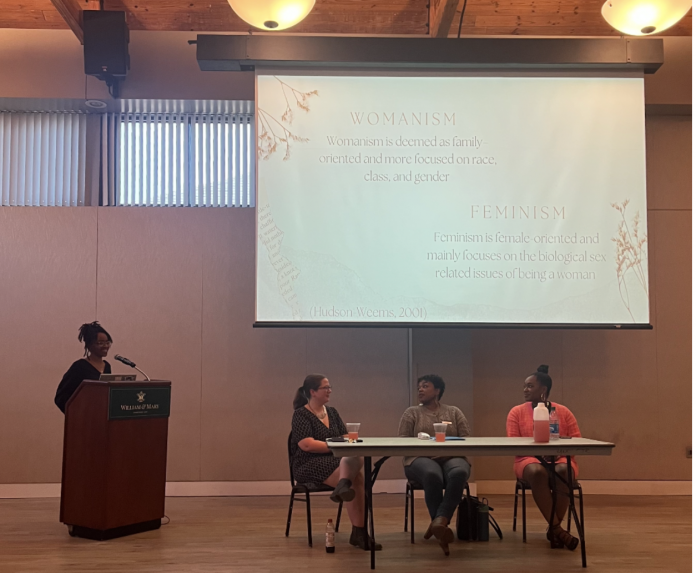Friday, March 24, the College of William and Mary’s Brown Table Talk, ESSENCE: Women of Color and the Women’s Network hosted a panel discussion titled “Womanism vs. Feminism” in Sadler Center Tidewater A. The event featured three guest panelists and a group discussion on various topics and debates related to womanism and feminism, especially concerning the intersectionality of both movements.
The panelists included CEO of Psych Your Mind, Crystal Joseph ’09, a licensed mental health therapist in Virginia and Maryland who is devoted to multi-cultural mental health. The second panelist was assistant professor of government and gender, sexuality and women’s studies Claire McKinney. McLeod Tyler Wellness Center clinical psychologist Dr. Stacie Otey-Scott served as the third member of the panel.
Before beginning the panel questions, the panel presentation differentiated womanism as “more focused on race, class and gender,” whereas feminism is “mainly focused on the biological sex related issues of being a woman.”
McKinney began the conversation by explaining the importance of race in the discussion of womanism and feminism, then gave an example of how women in the workplace are seen differently between womanists and feminists. She discussed how historically, white, feminist women started a movement to gain better educational and work opportunities beyond staying at home as a mother or housewife.
Conversely, womanists understood that women of color did not have the opportunity to be a housewife, as they had to work out of necessity. Additionally, if white women were beginning to work, then women of color would become the new caretaker: an often underpaid and under-protected occupation.
This sentiment resonated with many people at the panel, including Amaya Jones ’25, the lead facilitator of Brown Table Talk.
“Especially in this age of media, our generation is like ‘No, I don’t dream of working. I dream of being able to stay home and take care of my family,’” Jones said. “That’s not something that I dream of or something that I feel like some of my other minority [classmates/friends] dream of. I want to make my mark because so many of my ancestors have done the work so that I have this opportunity, so [staying home] is not necessarily something I aspire to do.”
“I want to make my mark because so many of my ancestors have done the work so that I have this opportunity, so [staying home] is not necessarily something I aspire to do.”
Joseph then discussed the role of womanism and family in Black mental health. As a therapist with mostly Black clients, Joseph often sees the struggles that many Black women face related to family, ranging from topics such as generational mental health issues to childcare. She understands the importance of having a strong support system and family, whether blood-related or chosen, which womanism advocates for.
“My clients view me as family,” Joseph said. “They view me as part of their village and their tribe because without me they wouldn’t be able to make certain headway in their life and their experiences.”
Otey-Scott then discussed how to educate others on womanism and feminism, while not “othering” them. Othering is when an individual or group is labeled as not fitting into social norms. She explained that it is a mechanism that most humans use to cope with differences, however, it is not a good mechanism to use.
“Right now, we are in a situation nationwide that we are so dichotomous in our thinking and there is so much division, that it is really hard to recognize that we should be operating from a place of love,” Otey-Scott said.
She emphasized the importance of inclusivity and love to lessen a “me-versus-you” narrative. Otey-Scott explained that breaking down these barriers will allow others to feel more comfortable when learning about womanism and feminism, and will also help womanists and feminists work better with one another.
Vice President of Diversity, Equity and Inclusion for the Women’s Network College chapter Rachel Oduntan ’25 shared how pleased she was with the involvement in this discussion.
“What I enjoyed about the panel discussion was the stimulation,” Oduntan said. “Everybody was involved. No one was afraid to say how they felt.”
This discussion provided various views, from academic and medical, to personal and heartfelt. One question at the end of the discussion concerned an individual’s ability to be both a womanist and a feminist, given their distinctive ideas. McKinney answered this question by paraphrasing a quote from novelist Alice Walker.
“The way that Alice Walker thinks about it is that it’s like lavender to purple,” McKinney said. “In which case, right, we see tremendous overlap and yeah, you can be a womanist and a feminist.”

